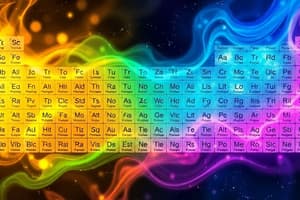Podcast
Questions and Answers
What is the relationship between the size of the halogen atom and the carbon–halogen bond length?
What is the relationship between the size of the halogen atom and the carbon–halogen bond length?
- The carbon–halogen bond length decreases as the halogen atom size increases.
- The carbon–halogen bond length increases as the halogen atom size increases. (correct)
- The carbon–halogen bond length is directly proportional to the square of the halogen atom size.
- The carbon–halogen bond length is independent of the halogen atom size.
Which of the following is a characteristic of fluoromethane?
Which of the following is a characteristic of fluoromethane?
- It is non-polar and has a medium C–X bond length.
- It has a strong C–X bond and a short C–X bond length. (correct)
- It has a weak C–X bond and a long C–X bond length.
- It is highly polar and has a medium C–X bond length.
What is the trend in the polarity of the methyl halides as one progresses from fluorine to iodine substitution?
What is the trend in the polarity of the methyl halides as one progresses from fluorine to iodine substitution?
- The polarity fluctuates randomly as one progresses from fluorine to iodine substitution.
- The polarity decreases as one progresses from fluorine to iodine substitution. (correct)
- The polarity remains constant as one progresses from fluorine to iodine substitution.
- The polarity increases as one progresses from fluorine to iodine substitution.
What is the relationship between the size of the halogen atom and the carbon–halogen bond strength?
What is the relationship between the size of the halogen atom and the carbon–halogen bond strength?
Which of the following is a characteristic of iodomethane?
Which of the following is a characteristic of iodomethane?
Flashcards are hidden until you start studying
Study Notes
Halogen Atom Size and Carbon-Halogen Bond Properties
- Halogen atom size increases as you go down the periodic table, with fluorine being the smallest and iodine being the largest.
- As you go down the periodic table, the carbon-halogen bond length increases, and the carbon-halogen bond strength decreases.
- The electrostatic potential maps at the van der Waals surface illustrate the trend in polarity, C–X bond length, and halogen atom size for the four methyl halides.
- Fluoromethane has the highest polarity, shortest C–X bond length, and strongest C–X bond.
- Iodomethane has the lowest polarity, longest C–X bond length, and weakest C–X bond.
- The trend in carbon-halogen bond properties can be observed in the methyl halides, with fluorine substitution resulting in the strongest and shortest bond, and iodine substitution resulting in the weakest and longest bond.
Studying That Suits You
Use AI to generate personalized quizzes and flashcards to suit your learning preferences.




